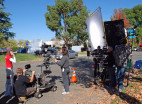 My father, for whom I have all the respect in the world, grew up in New York City with its asphalt jungle and was never exposed to the wonders of nature all around him. He would proudly proclaim there were only two types of snakes that he disliked: live ones and dead ones.
My father, for whom I have all the respect in the world, grew up in New York City with its asphalt jungle and was never exposed to the wonders of nature all around him. He would proudly proclaim there were only two types of snakes that he disliked: live ones and dead ones.
As much as I respected and loved my father, he was wrong. Unfortunately, there is still a large number of people who feel like he did.
Now that I am living in Santa Clarita, I have had the opportunity to observe many different reptiles in the field, including snakes. Some of these snakes have been the common Southern Pacific rattlesnake, which along with a number of other species considers Santa Clarita to be its home.
Rattlesnakes are common residents all over Southern California. They were here long before man, and when man, in the form of the Tataviam and Chumash Indian tribes, migrated into Southern California, they lived in harmony with all of the animals – including the rattlesnakes.

This Southern Pacific rattlesnake was coming on to my front porch in Newhall when I was taking out the trash. I took this photo with the assistance of a telephoto lens but then backed off and went out through the garage.
For reasons not immediately apparent, there seem to be increased sightings of rattlesnakes in the hills and valleys around us this season. Indeed, they are showing up our own proverbial back – or, as in my recent experience – front yards. As such, I thought it valuable to review some facts about rattlesnakes in general and our own Southern Pacific rattlesnake in particular, as well as correct some common myths so that everyone will be more knowledgeable (if not more comfortable) with the snakes that live in our local hillsides and even backyards.
Characteristics
Rattlesnakes, indeed all snakes, begin to appear locally sometime in March and can be expected to be active through October. If November, December, January and February are particularly warm, we could see them all year.
Rattlesnakes are our only venomous snakes. As a group, they are known as pit vipers. They have a heat-sensing depression (pit) between their nostril and their eye with which they can detect warm-blooded prey such as mice, rats, shrews, gophers and the like. Using their heat sensor, they can also judge the relative size of the heat source much like a person can easily differentiate a charcoal grill from a bonfire with his eyes closed.
If a person is in proximity to a rattlesnake, it will recognize the person as (a) a heat source and (b) far too large to eat. As such, it really doesn’t want to waste its poison – which also initiates the digestive process for the rattlesnake when it needs that poison to capture its next meal. A rattlesnake that has recently delivered its poison into any source might then not have sufficient poison left to envenomate the animal the next time it strikes.
It is estimated that 25 percent of rattlesnake bites are dry; no venom is injected. But it is still a good idea to have it checked out and not wait until symptoms start to develop (or don’t develop, if no venom was injected). Bottom line, the snake does not want to waste its poison on something it cannot eat. So it will only strike, in this setting, if frightened or provoked.

Don’t mistake this friendly gopher snake for a rattler. The gopher snake’s head is only about as big around as its neck.
Rattlesnakes have a characteristic appearance. One cannot totally rely on coloring, since other snakes such as the gopher snake has similar patterning to confuse possible predators into thinking it might be a rattlesnake. Rattlesnakes tend to have a relatively heavy body compared to the thinner bodies of our non-poisonous local snakes such as the gopher snake and California king snake. But thinner or thicker is all relative and depends on how many snakes of each type you have seen.
The non-poisonous snakes also have a thin head that is no wider than its neck. The rattlesnake, on the other hand, has a diamond-shaped head where the back of the head is wider than the front, and much wider than the neck just behind it. This is where the poison glands are located and give the rattlesnake head its characteristic appearance.
Our Southern Pacific rattlesnakes tend to be relatively non-aggressive. They would just as soon sneak away than get into a fight, particularly with an animal larger than itself – and that includes all adults and any of our children. Still, if provoked or frightened, it will strike back in an effort to protect itself.

Contrarily, the back of the Southern Pacific rattlesnake’s head is 2 to 3 times thicker than its neck.
If you encounter a rattlesnake on the trail while hiking or even in your own backyard, simply stop and slowly move backward away from it. It will usually slink away. Do not pick up a stick or use your walking stick to hasten it on its way. That is only likely to provoke it. Also, yelling at it to go away will do no good, as snakes to not have any ears and cannot hear you, no matter how loud you yell. Snakes can feel vibrations, so stomping heavily on the ground will send a message that (a) you are there and (b) you are quite large – even a petite lady or a young child is large to a rattlesnake – so it would rather sneak away.
Snakes are not territorial, so there is nothing to defend as some of the larger mammals might do if confronted in the field. If encountered in your backyard, do NOT try to catch it. Rather, pay attention to where it goes, keep your children and pets inside, and call Animal Control (661-257-3191). While Animal Control will come and capture it, they are unlikely to kill it. Instead, they will release it in a remote area where there are few if any people.
If you’re out hiking and you come across a fallen tree across the trail or a large boulder – but not so large that you couldn’t step over it – resist the urge simply to step or jump over it. Snakes like to hide under fallen logs and in the tight space between the ground and a boulder. If you step over it, you can frighten the snake and it will strike. It need not first rattle its tail, nor does it need it assume the strike pose – particularly if your boot or show is in close proximity to its head.
Hence, also do not go barefoot or wear flimsy sandals when in the field. Never put your feet or your hands where you cannot see them. Step up onto the log or boulder. This will create vibrations, which will give the snake some warning, even though it hasn’t seen you yet. It might then begin to rattle, which is its warning to you that you should back off and not continue in a forward direction – at least not until the snake has left the area.
Eco-Friendly Exterminators
Rattlesnakes are an important part of our ecosystem. They consume large numbers of mice, rats, gophers and small ground squirrels, helping to keep the number of these animals and other vermin in check. They also serve as food for larger predators including the red-tailed hawk, coyotes, roadrunners and even other snakes, specifically the king snake, which is resistant to the rattlesnake venom.
It has been estimated that only 20 percent of young rattlesnakes make it to their second year due to predation, habitat destruction and extermination campaigns. Some people are like my father, although he never saw a rattlesnake in the field (only in zoos) and would kill any snake he might see. That is both unwarranted and unnecessary. The rattlesnakes are helping to keep the local rodent population in control.

Rattlesnakes don’t attack things bigger than they are unless provoked. This small rattler in Placerita Canyon had just killed a lizard for a meal but turned tail and slithered away when the photographer approached.
Rattlesnake bites are the leading cause of snakebite injuries in the United States. However, they rarely bite unless provoked or threatened and, if treated promptly, are rarely fatal.
In the case of a rattlesnake bite, do NOT place a tourniquet between the bite site and the central part of the body. Also, do NOT cut into the bite and suck out the poison, as was recommended decades ago.
First, remain calm, which is easier said than done. Next, call for help. If you have a cell phone and there is reception, call 9-1-1 and inform them you have been bitten by a rattlesnake, and tell them where you are. If in the field, you might need to hike out for them to reach you or even to get cell phone coverage.
When hiking in the field, it is best to have a companion along for multiple reasons, this being only one of them. If at all possible, get a picture of the snake (most cell phones have camera capability), particularly in areas other than Santa Clarita, as different snakes require different antivenins. A family member or friend can also drive you to an emergency room, but it is better to call 9-1-1. The emergency team can radio ahead, and they often know if the nearest hospital can or cannot handle a snake bite envenomation. If not, they will take you to the hospital than can handle the problem, whereas time is lost if you go to the nearest hospital and it is not equipped to care for snakebites. Also by the paramedics notifying the ER as to the specific problem, the ER will be ready for you rather than having potentially to wait in line until you can see the triage nurse before treatment can begin.

Another rattler in Soledad Canyon makes an escape rather than confront a hiker.
What about dogs? When hiking in the hills and trails around Santa Clarita, keep your dog on a leash. Not only can the dog run through poison oak – which will not affect it, but the oils coating its fur can be transferred to you when the dog returns and you rub it or otherwise play with it – but also, the dog is more likely to encounter a rattlesnake off the trail than on the trail. If it is bitten when it tries to get close to investigate, you will need to carry it out and get it to medical attention as quickly as possible.
There are aversion programs available for dogs, usually given in the spring when rattlesnakes first start appearing. Most veterinarians’ offices can provide information about such programs. Also, there is a rattlesnake vaccine available. Again, check with your vet. A good friend who works in the Santa Clarita Valley decided to return home for lunch rather than eat out and found that his dog had been bitten by a rattlesnake that that come into the back yard. He was able to get his pet to the vet in time to save him, but at a cost of thousands of dollars.

Keep an eye out for snakes when hiking on local trails. Its camouflage made this baby rattler difficult to see as it sunned itself in the middle of a trail in Placerita Canyon. It wasn’t looking for trouble, but if an unwary hiker had stepped on it, it could have been a problem.
It used to be said that one can determine the age of a rattlesnake by counting the individual buttons that make up its tail. This is a myth. A new button forms each time the snake sheds its skin, and if it has plenty of food, it could shed its skin multiple times in a season. The buttons may also break off. Further, one really does not want to get sufficiently close to the snake to count the number of buttons that make up its tail. (You can use a camera with a telephoto lens, which is how all the photos in this article were obtained – or use binoculars.)
In summary, rattlesnakes and other snakes are our neighbors. They help to keep the vermin population in check. They were here long before man moved into the Santa Clarita Valley. They are an important part of the local ecosystem. They do not want to fight with you; they would much rather go on their way and do their thing. But if you insist and threaten or provoke them, they will strike back to protect themselves. So if you do encounter a rattlesnake, particularly in your backyard, call Animal Control to remove it rather than killing it.
One additional point: Do not handle the head of a recently killed rattlesnake. There could still be reflexes, and dead snakes have been known to bite. Also, if not careful, you could accidentally puncture a finger or other body part and envenomate yourself – even from a dead snake.
Paul A. Levine is a docent-naturalist at Placerita Canyon Nature Center and an avid butterflier.

All snakes shown here are “local” except for this one. It’s a black-tailed rattlesnake in southeaster Arizona. We saw it crossing the road and just had to stop the car to get some pictures. It was exposed and felt threatened by a whole car load of people approaching it, so it assumed the classic strike position and vigorously rattled its tail.
Like this:
Like Loading...
Related





 Tweet This
Tweet This Facebook
Facebook Digg This
Digg This Bookmark
Bookmark Stumble
Stumble RSS
RSS
















































REAL NAMES ONLY: All posters must use their real individual or business name. This applies equally to Twitter account holders who use a nickname.
10 Comments
I don’t like snake huh!
Rattlesnakes are beautiful creatures and I am in awe of them! We come across plenty of them on our ranch and I teach my kids to respect them and appreciate them!
friend. play with them
Nice, informative article.
Leon, as the editor added two photos to my article and that is fine. However on the 3rd photo from the end with a caption that the rattlesnake is trying to leave the area, I think the snake is a California King Snake (it also doesn’t want anything to do with people) but not only does it eat all the little vermin that we do not want in our back yards, it can and does eat rattlesnakes.
Hi Paul! See the rattles on it? It was a really big rattler in Soledad Canyon.
Play with them? They will kill you?? I understand to appreciate them and teach but never go near
Admire them. They are more scared of you and they keep the rodent population down.
Great article Paul. But I disagree, that is a rattler, see the rattles. Yes, toward the tail the pattern is a bit strippy, but if you look at the other pics, they are too. Very informative.
Great article Paul. Very informative.